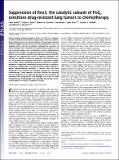| dc.contributor.author | Doles, Jason D. | |
| dc.contributor.author | Oliver, Trudy | |
| dc.contributor.author | Cameron, Eleanor Ruth | |
| dc.contributor.author | Hsu, Gerald | |
| dc.contributor.author | Jacks, Tyler E. | |
| dc.contributor.author | Walker, Graham C. | |
| dc.contributor.author | Hemann, Michael | |
| dc.date.accessioned | 2011-07-20T20:09:29Z | |
| dc.date.available | 2011-07-20T20:09:29Z | |
| dc.date.issued | 2011-07 | |
| dc.date.submitted | 2010-08 | |
| dc.identifier.issn | 0027-8424 | |
| dc.identifier.issn | 1091-6490 | |
| dc.identifier.uri | http://hdl.handle.net/1721.1/64940 | |
| dc.description.abstract | Platinum-based chemotherapeutic drugs are front-line therapies for the treatment of non-small cell lung cancer. However, intrinsic drug resistance limits the clinical efficacy of these agents. Recent evidence suggests that loss of the translesion polymerase, Polζ [Pol zeta], can sensitize tumor cell lines to cisplatin, although the relevance of these findings to the treatment of chemoresistant tumors in vivo has remained unclear. Here, we describe a tumor transplantation approach that enables the rapid introduction of defined genetic lesions into a preclinical model of lung adenocarcinoma. Using this approach, we examined the effect of impaired translesion DNA synthesis on cisplatin response in aggressive late-stage lung cancers. In the presence of reduced levels of Rev3, an essential component of Polζ [Pol zeta], tumors exhibited pronounced sensitivity to cisplatin, leading to a significant extension in overall survival of treated recipient mice. Additionally, treated Rev3-deficient cells exhibited reduced cisplatin-induced mutation, a process that has been implicated in the induction of secondary malignancies following chemotherapy. Taken together, our data illustrate the potential of Rev3 inhibition as an adjuvant therapy for the treatment of chemoresistant malignancies, and highlight the utility of rapid transplantation methodologies for evaluating mechanisms of chemotherapeutic resistance in preclinical settings. | en_US |
| dc.description.sponsorship | National Institutes of Health (U.S.) (Grant RO1 CA128803) | en_US |
| dc.description.sponsorship | National Cancer Institute (U.S.) (Koch Institute Support Grant P30-CA14051) | en_US |
| dc.description.sponsorship | National Institute of Environmental Health Sciences (Grant ES015818) | en_US |
| dc.description.sponsorship | Massachusetts Institute of Technology. Center for Environmental Health Sciences (Grant P30 ES002109) | en_US |
| dc.description.sponsorship | Massachusetts Institute of Technology. Dept. of Biology | en_US |
| dc.description.sponsorship | Ludwig Center for Molecular Oncology Graduate Fellowship | en_US |
| dc.language.iso | en_US | |
| dc.publisher | National Academy of Sciences (U.S.) | en_US |
| dc.relation.isversionof | http://dx.doi.org/10.1073/pnas.1011409107 | en_US |
| dc.rights | Article is made available in accordance with the publisher's policy and may be subject to US copyright law. Please refer to the publisher's site for terms of use. | en_US |
| dc.source | PNAS | en_US |
| dc.title | Suppression of Rev3, the catalytic subunit of Pol zeta, sensitizes drug-resistant lung tumors to chemotherapy | en_US |
| dc.title.alternative | Suppression of Rev3, the catalytic subunit of Polζ, sensitizes drug-resistant lung tumors to chemotherapy | en_US |
| dc.type | Article | en_US |
| dc.identifier.citation | Doles, J. et al. “Suppression of Rev3, the Catalytic Subunit of Pol , Sensitizes Drug-resistant Lung Tumors to Chemotherapy.” Proceedings of the National Academy of Sciences 107.48 (2010) : 20786-20791. | en_US |
| dc.contributor.department | Massachusetts Institute of Technology. Department of Biology | en_US |
| dc.contributor.department | Koch Institute for Integrative Cancer Research at MIT | en_US |
| dc.contributor.approver | Hemann, Michael | |
| dc.contributor.mitauthor | Doles, Jason D. | |
| dc.contributor.mitauthor | Oliver, Trudy | |
| dc.contributor.mitauthor | Cameron, Eleanor Ruth | |
| dc.contributor.mitauthor | Jacks, Tyler E. | |
| dc.contributor.mitauthor | Walker, Graham C. | |
| dc.contributor.mitauthor | Hemann, Michael | |
| dc.relation.journal | Proceedings of the National Academy of Sciences of the United States of America | en_US |
| dc.eprint.version | Final published version | en_US |
| dc.type.uri | http://purl.org/eprint/type/JournalArticle | en_US |
| eprint.status | http://purl.org/eprint/status/PeerReviewed | en_US |
| dspace.orderedauthors | Doles, J.; Oliver, T. G.; Cameron, E. R.; Hsu, G.; Jacks, T.; Walker, G. C.; Hemann, M. T. | en |
| dc.identifier.orcid | https://orcid.org/0000-0001-5785-8911 | |
| dc.identifier.orcid | https://orcid.org/0000-0003-0179-9216 | |
| dc.identifier.orcid | https://orcid.org/0000-0001-7243-8261 | |
| dspace.mitauthor.error | true | |
| mit.license | PUBLISHER_POLICY | en_US |
| mit.metadata.status | Complete | |
